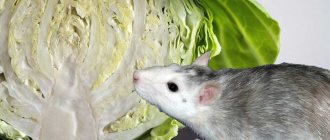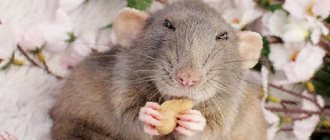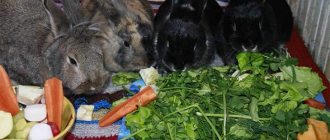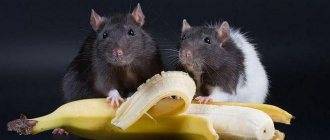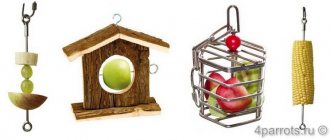Rats are animals that will eat almost anything you offer them. However, although they can safely eat a wide variety of foods, there are some foods that should be avoided. Knowing which foods are safe and which to avoid is important knowledge for any rat owner. Proper feeding of your rat plays an important role in ensuring its happy and healthy life.
In this article, we will take a closer look at how dairy products such as cheese, milk, kefir, sour cream, cottage cheese and yogurt affect the rat’s digestion. Is dairy safe for them or should they be avoided? You will find out the answer to this question if you continue reading this article.
Can a rat have milk?
Regardless of whether it is beneficial for them; rats will drink milk if you give it to them. In fact, they really like it and will drink a lot - right to the bottom of the bowl. There are many reviews from rat owners that confirm this. Although they are very intelligent rodents, they do not have the intelligence developed enough to know that food will be problematic for them. This is why if you are going to serve them milk, you need to consider the type and quantity.
- How to prepare milk for rats?
To prevent the milk from harming your pet, you need to boil it and give it to the rat after it has cooled. It is not recommended to serve cold or hot milk to rodents, as this can lead to digestive disorders.
- What is the best milk for rats?
Many people associate milk exclusively with cows, although it can come from a variety of animals, and there are many milk substitutes on the market today.
There are actually a number of dairy products that may be suitable for rats to consume. These types of milk are often used to feed rat pups who were left without a mother at an early age.
Let's now take a closer look at some of the main options below:
- Goat's milk
: It has less lactose and other sugars. It is also known that it has less fat content. All these factors facilitate the absorption of food. - KMR
: milk replacer for kittens. - Esbilac
: formula for puppies. - Enfamil:
A type of this milk that does not contain iron is suitable.
Although most of these types of milk are formulated for dogs, rats will be able to consume them safely. In addition, such formulas contain probiotics, vitamins, minerals, and are very easy to digest.
- What kind of milk should rats not eat?
There are types of milk that can be harmful to rats. For example:
- Soy milk
: causes increased gas formation and bloating in the animal's stomach. - Coconut milk
: Causes allergies in most rats. - Condensed milk:
It contains too much sugar, which is harmful to rodents.
It is also not recommended to give rats milk powder.
Main rules of feeding
Unlike their wild relatives, pets are very sensitive to food; diet is an important component of the health and life of the animal. They need to be fed in the morning and in the evening, due to the fact that animals are quite active at night, the main meal can be organized in the evening, for example, from 8 to 10 o’clock.
But many owners move the main meal to the morning, so the animals are active during the daytime, and at night they rest. Pregnant females are fed 4 times a day.
You need to be very careful when introducing new foods into your diet. The animal may have allergic reactions, so the portion should be very small the first time, be sure to monitor the reaction.
Animals need a variety of foods rich in vitamins and minerals, but the diet should include only healthy foods that are not harmful to health, these include:
- Cereals. They are rich in vitamin E, you can give corn, wheat, oats, millet, barley, seeds, oatmeal.
- Greenery. Dill, parsley, dandelion, plantain, cilantro, clover, radish.
- Vegetables. It should be given boiled without adding any spices.
- Meat. Only boiled and only lean, for example, chicken, turkey, beef. It is allowed to give meat puree, which is produced for kittens.
- Fish. Allowed in small quantities, only boiled, low-fat.
- Eggs. It is better to give hard-boiled quail. Should be on the menu no more than once a week.
- Nuts. Nuts are healthy, but only in small quantities. Almonds are prohibited.
- Dry food. You can buy food with a variety of additives at pet stores; they contain a large amount of vitamins and minerals.
- Fruits. These treats should only serve as treats and should be given rarely and in small quantities. It is forbidden to give peach and apricot pits; they contain hydrocyanic acid, which is a dangerous substance for rodents.
- Berries. They are very fond of raspberries, currants, blueberries, strawberries, but also, as in the case of fruits, rarely and in small quantities.
- Mineral supplements. Special mineral stones and chalk are also sold.
- Vitamin pills. You can buy special vitamins for the animal; a little fish oil is recommended.
The basis of the diet is cereals, herbs, vegetables, dairy products and cheese; they can only be an additive to the main diet. We must not forget that such supplements will only be beneficial in small quantities; if you do not adhere to this rule, you can harm your pet.
Can rats eat cheese?
If the cheese you give your rat is of good quality and made from natural products, then it is completely safe for the animal. However, too much cheese can upset your rat's stomach. Therefore, if your animal has never eaten cheese before, you should introduce it into the diet gradually.
Also, be very careful not to give too much gooey cheese that can get stuck in your mouth - like peanut butter and the like. Rats may not be able to chew such cheese into pieces small enough to be safely swallowed.
Cheeses that should not be given to rats:
- Mozzarella.
- Feta.
- Bree.
- Blue cheese.
- Mascarpone.
- Cream cheese.
- Ricotta.
- Stilton.
- Gorgonzola.
This is not an exhaustive list of cheeses that rats cannot eat. Always research the type of cheese you are going to give to your rats first and use common sense to decide whether it is safe or not.
While most cheeses are suitable for rats, some should be avoided, even as occasional treats.
It's also worth keeping in mind that while rats are generally not lactose intolerant, some rats can be allergic to dairy products. Therefore, it is worth paying attention to signs that they do not tolerate cheese well, such as diarrhea or loose stools.
The best cheeses for rats are hard or semi-hard cheeses that have been washed to remove excess whey, reducing lactose and fat content.
Scientists' answer
Scientists from the UK were interested in the question of why mice love cheese. They conducted a number of experiments with mammals.
Experience has shown that mice prefer to eat plant foods, and they do not like the smell of cheese at all. Particularly odorous varieties evoke a feeling of danger, and they try to avoid the suspicious object.
An animal living in the wild will eat cereals and fruits, and will only eat other food in case of severe hunger. In the forest or in the field you will not find products created by man. Therefore, it is not surprising that the mammal loves natural food. It looks and smells safe.
Scientists from the British organization Pest Control UK became interested in the results of their colleagues and conducted their own experiment. They used traps with various baits:
- cheese;
- apple;
- chocolate.
The results showed that mice eat cheese. The trap was set with this delicacy, and they liked to run into it the most. But chocolate did not arouse any interest among the animals.
It is likely that the experiment involved different species of mice and different types of treats, which is why the results are so different from each other.
On a note!
Exterminators assure that you should take sunflower seeds, flour, wheat, and unrefined oil as bait. Pests love this kind of food more.
Yogurt in the diet of domestic rodents
Rats can be given yogurt, but it should be done in moderation. Too much yogurt in the diet can cause digestive problems for your pet. We tend to think of rats as omnivores. While this is true for wild rats, it is not true for pet rats.
Obesity can be fatal for rats and other rodents, so their food intake must be closely monitored. When you are looking for yogurt to feed your rats, you need to go for the low-fat version.
It is not recommended to give your pet yogurts in different flavors due to the additives that add flavor to the yogurt. Although rats can eat many things, there are certain chemicals and flavors that they are highly allergic to.
Another thing to consider when making your decision is the amount of fat contained in Greek yogurt. Regular yogurt contains 5 grams of fat, while Greek yogurt contains 10 grams. If you are trying to focus on providing a healthy diet for your rat, Greek yogurt may not be the best option.
Kefir and your blood pressure
Disclaimer:
The information on this website has not been evaluated by the Food and Drug Administration and is not intended to diagnose, treat, treat, or prevent any disease. It is not intended to be a substitute for professional medical diagnosis, treatment, or even advice. You should always consult a qualified health care professional with questions about any medical condition. The information is not a substitute for medical or psychological treatment. Any results presented on this website are not a guarantee, guarantee or prediction as to an individual's outcome for any particular problem. Although all materials and links to other resources are provided in good faith, the accuracy, reliability, effectiveness, completeness or usefulness of any information herein or any publication cannot be guaranteed. Cultured Food Life Inc. assumes no responsibility for the use or misuse of the information contained on this website. We strongly recommend that you seek professional advice before making any health decisions. Here are two websites that can help you find a functional medicine/integrative medicine specialist near you: www.acam.org and www.functionalmedicine.org
If you purchase something through a link in this email or on the website, you should assume that we have an affiliate relationship with the company providing the product or service you purchase and that we will receive some payment. We recommend that you conduct your own independent research before purchasing anything.
© 2022 Cultured Food Life - All photographs, blogs, illustrations and graphic designs are originals unless otherwise noted. Don't steal, please.
.
What is it advisable to feed a rat?
As a pet rat owner, you need to know exactly what diet is best for your pet so that it can live a long, healthy life. Nutrition should be balanced and nutritious.
A rat's diet should consist of carbohydrates, fats, proteins, fruits and vegetables. Remember that a rat does not need an excessive amount of fat in its diet, so you must carefully monitor their fat intake to prevent the animal from becoming obese.
Most of your kitty rat's diet should consist of carbohydrates. You can try creating your own carbohydrate mixture to meet your rat's needs, or you can buy pre-made kibble specifically made for rats.
Remember that rats require minimal amounts of fat, so you need to be very aware of how much they consume. Here are some foods that can provide a healthy source of fat:
- Avocados - without skin, as it can make the rat very sick.
- Yogurt.
- Sunflower seeds.
- Eggs.
It is not recommended to include these high-fat foods in every rat's meal, but they can be given occasionally.
Rats also require protein intake to be healthy. Some sources of protein that can be given to your rat are:
- Chicken.
- Eggs.
- Nuts.
- Flax seed.
- Beans (butter and kidneys).
Even if you feed your rat exclusively pre-cooked food pellets, you should give them fruits and vegetables daily to balance their diet. You need to be careful when choosing fruits and vegetables. Rats cannot digest all fruits and vegetables.
Here are some fruits and vegetables that your rat can safely enjoy:
- Pears.
- Bananas.
- Strawberry.
- Blueberry.
- Melon.
- Apples - make sure all seeds are removed. Apple seed can be toxic to rats.
- Carrot.
- Broccoli.
- Dark green leafy vegetables.
- Pumpkin or zucchini.
This list is not a complete list of foods that your rat may enjoy, but it is a good starting point when it comes to providing a balanced diet for your pet. As with everything else, you need to feed these foods in moderation to keep your rat strong and healthy.
Choosing food
The basis of a rat's diet is a grain mixture. You need to choose a trusted manufacturer who maintains balance when formulating feed. If you can’t find good ready-made food, it’s better to cook it yourself than to buy low-quality food, which consists of almost 80% oats. A complete diet should include oats, wheat, barley and rye.
It is better not to take food in a cardboard box, as it is stored in unsealed packaging, and if it was near chemicals, the rat can easily get poisoned. You only need to buy formulations in airtight packaging, and it is better to do this not in a regular supermarket, but in a specialized veterinary store.
You can buy not only grain mixture, but also granulated food. This food is similar in composition to regular grain food; it is purchased when the rat eats selectively, eating the most delicious food and leaving the grain untouched.
Conclusion
Mice are vegetarians. They will eat seeds, vegetables and fruits faster than cheese. But this does not mean that mice will ignore the product in question. If there is nothing suitable, these rodents will eat anything, including cheese.
Sources
- https://FB.ru/post/nature/2018/6/19/27023
- https://zen.yandex.com/media/factusios/myshi-i-syr-pravda-li-chto-pervye-tak-liubiat-vtoroe-ili-eto-vrane-5e24a5eb32335400ac8d97ac
- https://apest.ru/myshi/vse-o-myshah/edyat-li-myshi-syr/
- https://klause.ru/gryzuny/lyubyat-li-myshi-syr.html
- https://KOTiKo.ru/krysy/pitanie-krys/mozhno-li-krysam-syr-moloko-tvorog-i-drugie-molochnye-produkty.html
- https://likehamster.ru/domashnie-krysy/pitanie-krys/molochnye-produkty-krysam/
- https://zen.yandex.ru/media/id/5ca4d38ad92e0900b447a942/chem-mojno-kormit-krysu-a-ot-chego-luchshe-otkazatsia-5ce80e1fb2297700b54b7f45
- https://homkin.ru/krysy/pitanie-krys/mozhno-li-krysam-syr-i-moloko.html
[collapse]
Where did the statement come from?
Adults are sure that the myth was spread by animators and illustrators of children's publications. But even in ancient times, people believed that small animals love to dine on this aromatic delicacy.
Previously, when there were no poisons and chemicals, the fight against mice consisted of keeping all supplies safely hidden in jugs and cabinets. The exception was cheese. It should have been left uncovered to mature. So the mice had to gnaw it out of hunger.
Animators made the image of an animal with a fragrant treat in its paws very popular. Now many are sure that mice really love cheese.
The main diet of rodents is sweet fruits and cereals. In nature, they build nests in fields where they can easily get grain. The pest's sensitive nose does not tolerate strong aromas and artificial products. Mice do not like cheese and will choose other foods over it if given a choice.
Favorite characters
According to another version, perhaps this image was simply well played out by animators and caricaturists who were able to perpetuate this myth for many years. Today it is much easier to imagine and draw a mouse with a delicious slice of cheddar than with a crust of bread and a few grains of rice.
The creators of the popular animated series “Chip 'n' Dale Rescue Rangers” went even further. One of the rescuers is named Rocky, and his full name is Roquefort - in honor of the famous cheese. His father is Charlie Cheder and his mother is Katie Camembert. The main weakness of this daredevil is his incredible love for cheese; from the mere smell he falls into a trance and tries with all his might to get to the coveted piece. But the author’s idea hardly has any connection with reality. Rather, it is a fiction, nothing more.
A little history
Who knows where this myth came from.
Most likely, the traces lead to the Middle Ages. Before the invention of the refrigerator, storing food was much more difficult, so everyone got out of the situation as best they could: meat was attached to a hook under the ceiling, grain was kept in bags or barrels, and large circles of cheese were covered with wax or wrapped in linen. In those days, a hungry mouse agreed to eat anything. Meat hanging from the ceiling was harder to get, wheat or cheese was much easier to access. But the loss of several grains from the bag is not so noticeable, and teeth marks are treacherously visible on a piece of cheese. This may have led many to believe that mice love cheese. Even if in fact they only eat it because it turned out to be their only prey.
What other fairy tales exist about this?
The next version of mice’s pseudo-love for cheese lies in the shortage of food in the homes of medieval residents.
Like, in those days there was tension with food
. She was sorely missed. There were minimal supplies in the house. As a result, it was difficult to establish the fact that mice were eating food.
Only teeth marks on the cheese served as clear evidence of the presence of mice in the house. This is what this version is based on, explaining the love of mice for cheese.
The next point is related to cartoons. The stereotype of a mouse with a slice of cheese was perpetuated by cartoonists. The rodent looked much better this way
than with some kind of grain.


